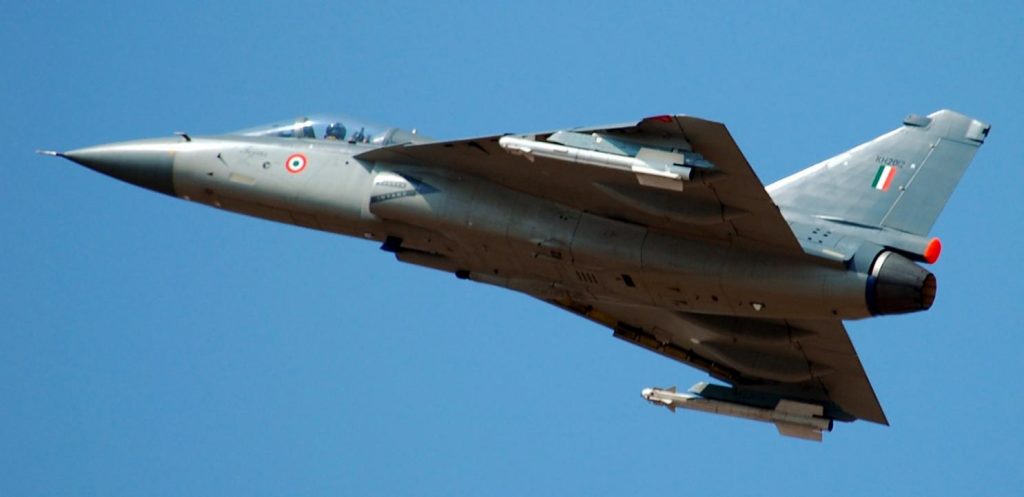The MiG-21 has been in the news again – for all wrong reasons. That aircraft has been the mainstay of the Indian Air Force’s (IAF) air combat capability for decades. However, current developments bring in focus the urgency of developing and deploying its replacement – the Tejas Light Combat Aircraft. The IAF plans to order a total of 339 Tejas aircraft of various marks over the years. These will form the mainstay of the IAF’s combat aircraft fleet for some decades. A small number is also to be ordered by the Indian Navy for carrier-based operations.
Fortunately, private companies are to undertake much of the manufacturing – Larsen & Turbo (wings), Dynamic Technologies (front fuselage), VEM Technologies (centre fuselage), and Alpha Design & Dynamics (rear fuselage). Hindustan Aeronautics Ltd. (HAL) will only undertake the final assembly and the like. As a result, Tejas’ production rate will increase to 24 aircraft a year. HAL, on its own, could not double the production rate from a mere eight to 16 aircraft a year. That would have taken it over 20 years to complete the production run – compared to just 14 years with the private companies in partnership. Importantly, this could help the private industry acquire skills like prime-contractorship and systems integration and someday make aircraft of their own design.
While the Aeronautical Development Agency (ADA) undertook design work on Tejas with zero experience, they did a commendable job of it. ADA had used advanced technology at every opportunity – advanced computational fluid dynamics for the aerodynamic design, a mock-up designed entirely on the computer for the first time in India, advanced carbon fibre composite material for the structure, advanced avionics in the cockpit, and the like. Dr Kota Harinarayana, the then Programme Director for LCA at ADA, had once said that the control laws for the Tejas’ Flight Control System had been test-flown on a US F-16D test aircraft. He had quoted the test pilot as saying that the aircraft actually handled better with Tejas’ control laws. Indian test pilots have praised Tejas’ high-speed handling characteristics, its high level of agility, and said it is easy to fly even at the limits of its operational flight envelope.
Admittedly, Tejas has some shortcomings, like having an inadequate payload/range performance, a high turnaround time between missions, being maintenance-intensive, etc. Some of these should be addressed on Tejas Mk 2, which will hopefully be up to what is called fourth-generation technology standards. Thus, the earlier Mk 1 and Mk 1A may serve, at best, as point-defence rather than area defence interceptors. They may not be adequate for the ground-attack role.
Some of the Tejas aircraft’s design features are interesting. It is the world’s smallest single-seat, single-engine combat aircraft. It is of tailless, compound delta-wing design. A single-engine aircraft is roughly 30 per cent cheaper to produce and operate than a twin. However, to meet high performance requirements, particularly for the ground attack role, many aircraft have twin engines.
A small size reduces the flyaway as well as life-cycle costs, and makes Tejas difficult to detect. However, it also reduces the vital payload/range performance. Analysts regard the larger Saab Gripen (the light single-engine multirole fighter aircraft manufactured by the Swedish aerospace company Saab) as the smallest practicable multi-role aircraft. Having a single crew reduces aircraft costs, but imposes a heavy workload on the pilot. That is countered with greater automation and computerisation in the cockpit.
Tejas is not designed for stealth. However, it’s very small size, the high percentage of non radar-reflecting composite material (about 45 per cent by weight), and the Y-shaped bifurcated air intakes that prevent radar reflections from the engine’s fan blades, make Tejas difficult to detect – by radar as well as by the Mark 1 eyeball.
To avoid detection, Tejas will also minimise the use of its own active radar sensor and depend on its passive Infrared Search & Track (IRST) instead. Similarly, it will depend on its datalink for communication with friendly aircraft, rather than use its radio, which would give its position away. The datalink also helps in the exchange of data among friendly aircraft as well as from AWACS.
Tejas will have a wide range of weapons, including short-range and beyond visual range (BVR) air-to-air missiles, laser-guided bombs, glide bombs, cluster bombs, a 23 mm cannon, and others. The Derby and R-73E missiles are “slaved” to the pilot’s Helmet Mounted Display and Sight. To hit an enemy target, he merely has to look in the direction of the target and release the missile. The missile will do the rest. The small BrahMos NG supersonic cruise missile will give Tejas the much-needed long range strike capability.
Being a major importer of weapons, India is naturally keen to export indigenously developed ones. To date, Egypt, Sri Lanka, the UAE and Singapore have “shown interest”. Period. India should wait till the Mk 2 is in service and all its limitations are removed before offering it. However, the trainer variant is not affected by the low payload/range performance of Tejas and could be offered earlier.
Tejas is likely to be developed further in the future and upgraded with such developments as Direct Voice Control (through verbal signals to the sensors), an engine thrust vectoring nozzle (for greater agility in flight as well as for better runway performance), hopefully a Variable Camber Wing (which will maintain high efficiency throughout its flight envelope) as well as a more advanced engine and others. Amazingly, ADA had displayed a Tejas model at Aero India 2019 with canard foreplanes. These could completely transform its performance. With these developments, India’s aerospace defence industry will have come of age.
Hormuz P. Mama
